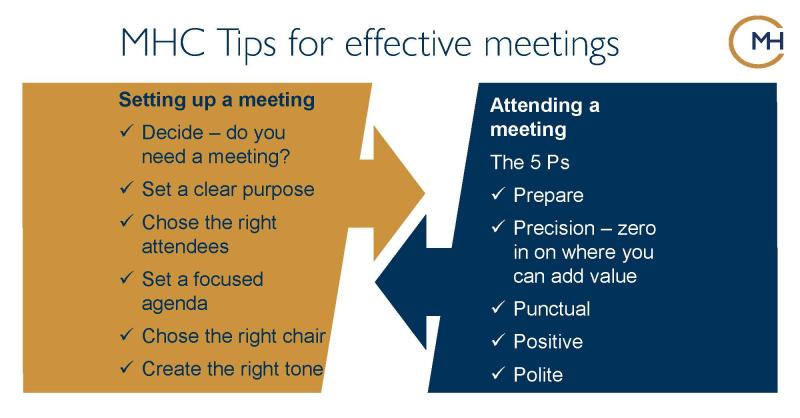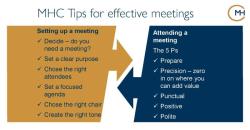Are the meeting recommendations prescriptive?
Whether meeting recommendations are prescriptive or suggested can depend on the context and the specific language used to convey the recommendations. Here's a distinction between the two:
Prescriptive Recommendations:
- Prescriptive recommendations are authoritative and often mandatory in nature. They leave little room for interpretation or discretion.
- Prescriptive recommendations use strong language and convey a sense of obligation or requirement. They are typically given when there is a clear and non-negotiable course of action to be followed.
- For example, a prescriptive recommendation might be: "You must attend the meeting at 2:00 PM without fail."
Suggested Recommendations:
- Suggested recommendations are more flexible and allow for some degree of discretion or choice.
- Suggested recommendations use milder language and indicate that the recommended action is a good idea but not mandatory. They acknowledge that other options might also be valid.
- For example, a suggested recommendation might be: "It's suggested that you consider attending the meeting at 2:00 PM, but if you have scheduling conflicts, please let us know."
In the context of meetings, recommendations can fall into either category depending on the tone, authority, and expectations of the organization or individual making the recommendation. It's important to pay attention to the specific wording and context to determine whether a recommendation is prescriptive or suggested.
Meeting Recommendations: Understanding Their Nature and Purpose
Meeting recommendations are suggestions or proposals put forward during or after a meeting to address specific issues, improve processes, or achieve desired outcomes. They serve as a roadmap for action and provide guidance on how to implement decisions made during the meeting.
Characteristics of Meeting Recommendations:
Action-Oriented: Recommendations should be specific, actionable, and measurable, providing clear steps for implementation.
Time-Bound: Recommendations should have defined timelines for completion, ensuring accountability and progress tracking.
Assign Ownership: Recommendations should clearly identify the individuals or teams responsible for carrying out the proposed actions.
Realistic and Feasible: Recommendations should be aligned with available resources, capabilities, and time constraints.
Purposes of Meeting Recommendations:
Decision Implementation: Recommendations provide a concrete plan for putting meeting decisions into action, ensuring that discussions translate into tangible outcomes.
Accountability and Tracking: Recommendations assign responsibility and establish timelines, facilitating accountability and progress tracking.
Future Reference: Recommendations serve as a record of decisions and action items, providing a reference point for future meetings and evaluations.
Process Improvement: Recommendations can identify areas for process improvement and suggest changes to enhance meeting effectiveness.
The Prescriptive Nature of Meeting Guidelines
Meeting recommendations often take a prescriptive approach, providing clear instructions and guidance on how to implement the proposed actions. This prescriptive nature is essential for ensuring that recommendations are translated into concrete outcomes and that everyone involved is on the same page.
Benefits of Prescriptive Recommendations:
Clarity and Direction: Recommendations provide clear instructions and directions, reducing ambiguity and ensuring that everyone understands the expected actions.
Consistency and Standardization: Prescriptive recommendations promote consistency in implementation and standardization across different departments or teams.
Reduced Errors and Misinterpretations: Clear instructions minimize the risk of errors, misinterpretations, and deviations from the agreed-upon plan.
Considerations for Prescriptive Recommendations:
Balance Structure with Flexibility: While structure is important, recommendations should allow for some flexibility to adapt to unforeseen circumstances or changing priorities.
Encourage Feedback and Adaptation: Recommendations should be open to feedback and adaptation as implementation progresses and new information emerges.
Involve Stakeholders in Development: Incorporate input from relevant stakeholders during the development of recommendations to ensure buy-in and support.
The Role of Recommendations in Meetings and Decision-Making
Meeting recommendations play a crucial role in the decision-making process, providing a bridge between discussion and action. They transform abstract ideas into actionable steps, facilitating the implementation of decisions and the achievement of desired outcomes.
How Recommendations Enhance Decision-Making:
Clarify Action Items: Recommendations clearly define the actions required to implement decisions, leaving no room for ambiguity or misinterpretation.
Identify Responsibilities: Recommendations assign ownership to specific individuals or teams, ensuring accountability and tracking of progress.
Establish Timelines: Recommendations set deadlines for completing tasks, promoting efficiency and preventing delays.
Guide Resource Allocation: Recommendations provide a framework for allocating resources effectively to support the implementation of decisions.
Measure Progress and Evaluate Outcomes: Recommendations facilitate the measurement of progress and evaluation of decision outcomes, informing future decision-making.


